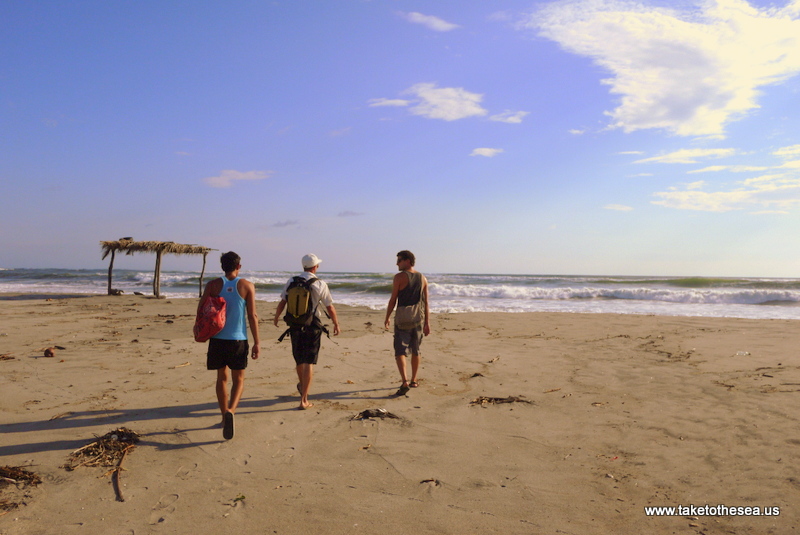
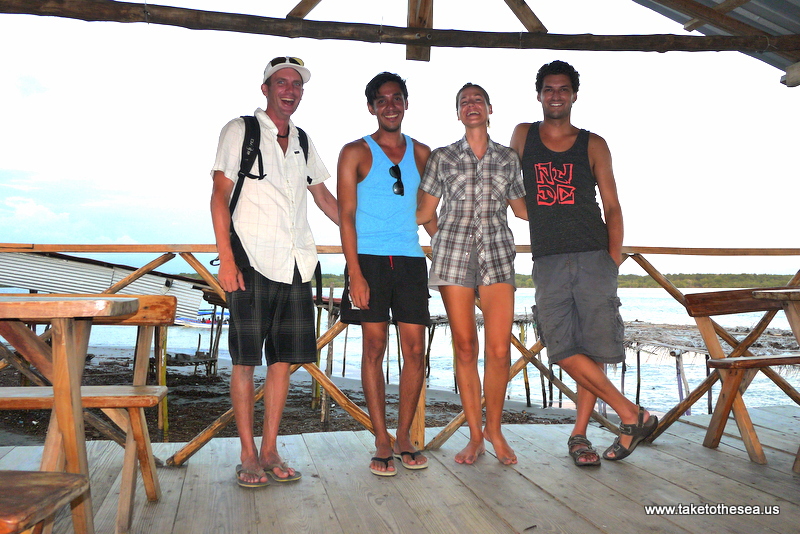
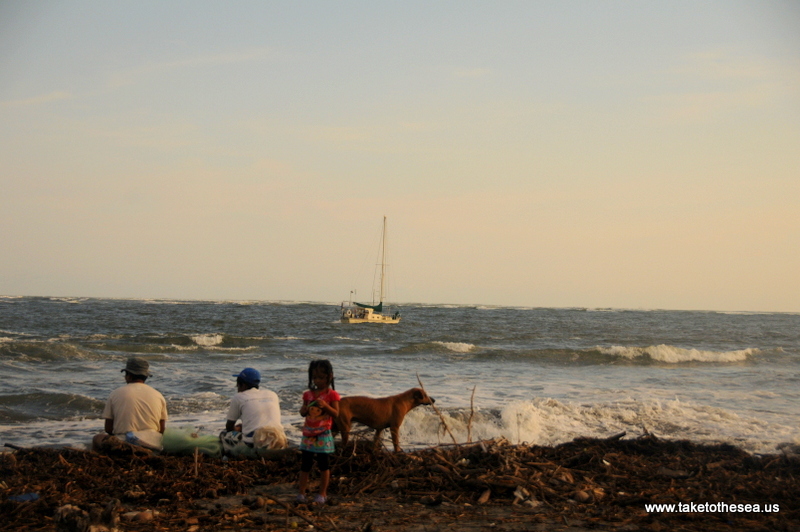
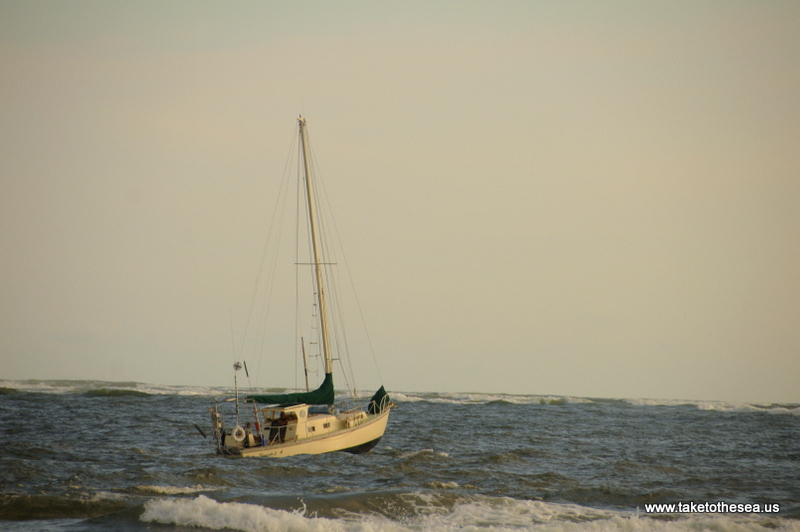
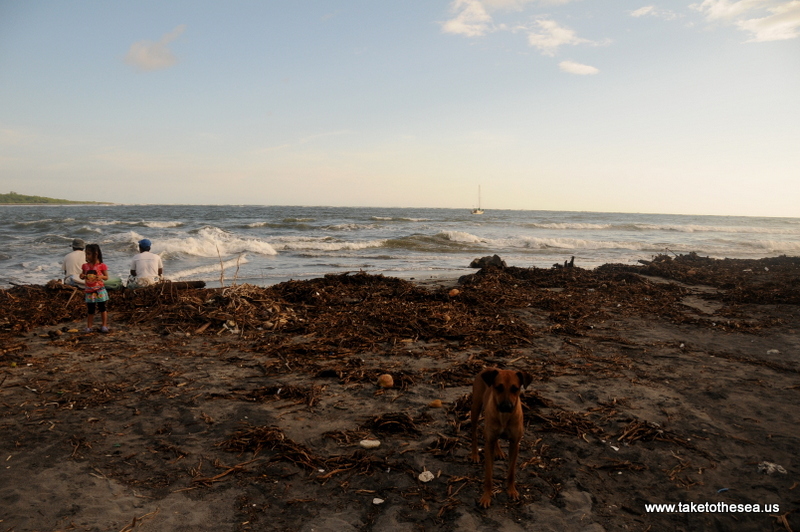
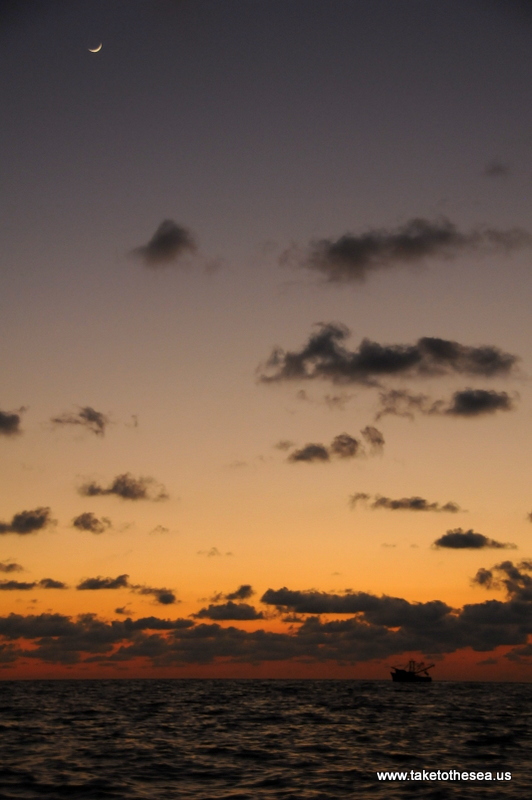
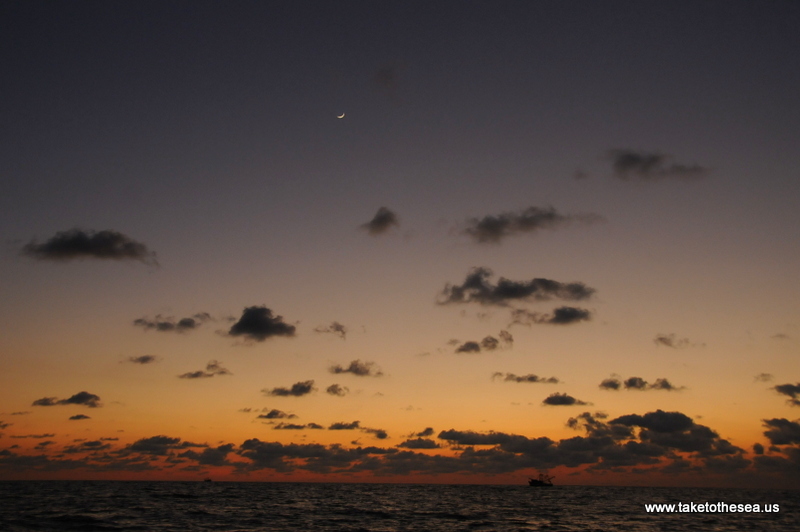
Log Book
- Port of departure: Bahia del Sol (Estero Jaltepeque), El Salvador
- Departure date and time: Tuesday, November 5, 2013 at 4:00pm
- Port of arrival: Punta Amapala, Gulfo de Fonseca, El Salvador
- Arrival date and time: Wednesday, November 6, 2013 at 10:00pm
- Total travel time: 1 day and 6 hours (30 hours)
- Miles traveled: 70.5 nm
- Engine hours: 1140.6 – 1147.7 – 7.1 hours
- Fuel consumption: 55 begin – 52.2 end – 2.8 gallons used
- Fuel economy: 24.8 mpg
- Weather: The forecast predicted light winds, not exceeding 6.5 knots. At night the wind was predicted to be mostly from the West, switching to a light North wind in the morning and then to the South in the middle of the afternoon. Winds were predicted to be lightest during mid-day, hovering around 2-3 knots. Pressure was predicted to drop by two millibars each evening, which could mean more storms, though the pressure drop is not significant and very little precip was predicted (0-0.02 inches on Tuesday).
- Tides and currents: High tide on Tuesday was at 3:55pm, which is the best time to cross the bar at Estero Jaltepeque. Low tide in the Gulf of Fonseca was at about 10:30pm on Wednesday, which meant we were fighting an ebb as we entered the Gulf. We’re looking at a 12 foot tidal shift, an important consideration for anchoring.
- Navigation notes: We maintained about a 5nm distance from shore to avoid the shallowest areas created by the Lempa River and Bahia Jiquilisque. We gave Punta Amapala a wide berth, ranging from 1 – 1.5 miles, to avoid wave action, though we could definitely still feel the effects of the current. There was a lot of panga traffic around sunset, especially as we neared the Gulf. We were dodging panga traffic on our way into the Gulf.
- Maintenance notes: Jeff sanded down our tiller and covered it in a fresh layer of epoxy and it feels smooth and solid – he also repaired the autopilot and the bracket that the autopilot sits on. Jeff has the engine running off of one of our water pumps (he removed the other pump) and she’s spitting water like a champ. We’re drawing diesel from our new old 35 gallon tank.
- Lessons learned: 1) Swimming off of the boat in the middle of the Pacific during a hot passage may dissolve any frustrations you have with flapping sails. 2) Sometimes it’s nice to just put the motor on.
It goes without saying that in order to start our passage we needed to cross the bar at the mouth of Estero Jaltepeque. High tide wasn’t until 4:00pm, however, so we had most of the day to finish up little tasks like picking up our laundry from Mar y Sol (a local restaurant, tienda, lavanderia), stock up on fresh produce from the trucks that drive up and down the main drag, clean up our cabin and put our dinghy away. 4:00pm came very quickly and we were eager to be on the other side of the bar. SV Saviah, a young couple nearing completion of a circumnavigation, was scheduled to cross the bar at the same time as us.
The evening prior we sat with the crew of SV Vagabundo on the second floor of a restaurant at La Puntilla and watched our friends Dave and Leiann on SV Chrysallis, another boat in the 30 feet and under club, plow through the waves. At one point we heard over the radio “The pilot isn’t sure you’re going to make it” but Dave kept on trucking and they powered through after waiting out a big set of waves. We were shoreside rooting them on.
I’m not sure if watching another boat cross the bar made me more anxious or more confident. Regardless, unless we wanted to call Bahia del Sol home we had to cross it and conditions on Tuesday were looking good. We motored towards la boca (the mouth) with SV Saviah trailing close behind. All I can really say about the crossing was that it was uneventful. I recorded a really long (20 minute!) video in which we talk about how boring the video will be and how no one will want to watch it (I’ll upload it once we have reliable internet). As before, the pilot Rogelio was expert and led both boats out of the estuary without incident.
On the other side of the bar we were pleased to discover a steady wind (10-13 knots) at our side (from the N/NE). We parted ways with SV Saviah, as they were headed north, and hoisted our main and genoa. Before long we were sailing along at 4.4 knots as the sun set and a sliver of moon, now illuminated, continued its descent towards the horizon.
Eventually the wind shifted to the N and lessened to 8-10 knots. On a broad reach we were able to still make about 4 knots. Given the calm conditions Jeff proposed we try 6 hour shifts. He would start at 9pm and be on shift until 3am. At 1:00am he woke me with some unpleasant information. There was a storm ahead. He had already reefed the main and was packing up the genoa in preparation – clearly expecting the worst.
Exhaustion registered in his face and in his movements so I offered to start my shift early, turning the planned 6 hour shifts into 4.5 hour shifts instead. There was still a pleasant wind, now almost directly at our back and with just the reefed main alone, we were still making 2.5 knots, leaving me to believe there must have been a considerable current helping us along.
I sat in the dark waiting for the storm to arrive, ready to heave to and wait it out. But the wind never came. I lie, there was wind, there just wasn’t much of it. The wind was light and inconsistent and the lightning was bouncing around far above us. It was a storm, but a different one than we had experienced to date. What this storm lacked in wind, lightning and thunder, however, it made up for in rain.
I sat down below in the dry(ish) cabin as the fat drops scoured our decks. The heavy rain diminished after 30 minutes, leaving a drizzly trail behind it and I grudgingly climbed back into the now wet cockpit and tried to make sense of the sloppy wind that followed in the wake of this rainstorm. Wet, cold, grumpy and having little success figuring out what the wind was up to I opted for the motor since we had been sitting outside of Bahia Jiquilisque for nearly 4 hours with little forward progress.
On day two we had light winds during the day, primarily on our nose, but were able to maintain at least 2 knots of speed. Seeking relief from the stifling mid-day sun we jumped into the ocean and let Serenity pull us along at 1.5 knots. A refreshing, fun reprieve after sitting and sweating in the sun all day.
Later in the afternoon, as we crept towards nightfall, the wind died down and we bobbed along. We would have been content to wait for the wind if a panga hadn’t materialized out of nowhere and suspiciously pulled alongside us. In a friendly, welcoming voice Jeff said good afternoon and asked the two young guys, Que pasa? What’s going on? They replied by saying nada, nothing. Which wouldn’t be a strange response if we were chit chatting on a street corner, but it’s awfully creepy when you pull up to a stranger’s boat in the middle of the ocean and don’t have a reason. They spoke quietly to each other and looked towards shore. That’s when we noticed three other pangas, all with similar coloring, heading straight for us.
Adrenaline started pumping. We turned on the motor, Jeff grabbed his machete, I grabbed my pepper spray, we tuned our HAM to the maritime frequency and were prepared to lock ourselves in our cabin and start calling mayday should the need arise. Fortunately nothing happened, no one followed us. They were probably just fisherman who wanted to check out the latest oddity. Or maybe “hey how about over by that red sailboat” was just a logical meeting place. I don’t want to be paranoid, but I also don’t want our boat to be boarded by armed men in the middle of the ocean where we are more or less helpless.
The wind picked up at our back again that evening after sunset and we had a great angle on the Gulf of Fonseca. As we neared the Gulf, however, we could feel the rip of an outgoing current, making the seas thick like syrup and slowing our speed. We hoped to be at anchor by 8:30, but the counter current set us back by an hour and a half.
The closer we got to Punta Amapala, which guards the entrance to the Gulf, the more fishing traffic we encountered. Little pangas, whose outlines were barely noticeable in the dark, flashed small lights, alerting us to their presence. We doused the sails and finished the final leg under motor to give us greater maneuverability. We tucked behind Punta Amapala, anchored in 18 feet of water and had the same thing for dinner that we had the night prior – eggs with green beans and tomatoes with a side of fried plantains. Yum.
I take it that Harmony wrote this blog segment. You are quite a detail person, I like it. Having that panga come
I take it that Harmony wrote this entire blog segment. You’re a real "detail" person, I like it, and a fine writer. When the panga came along side MY adrenaline started pumping too. Enjoying your adventures.
Thanks! Sometimes I can go a bit overboard with the deets :). So glad someone else appreciates them.